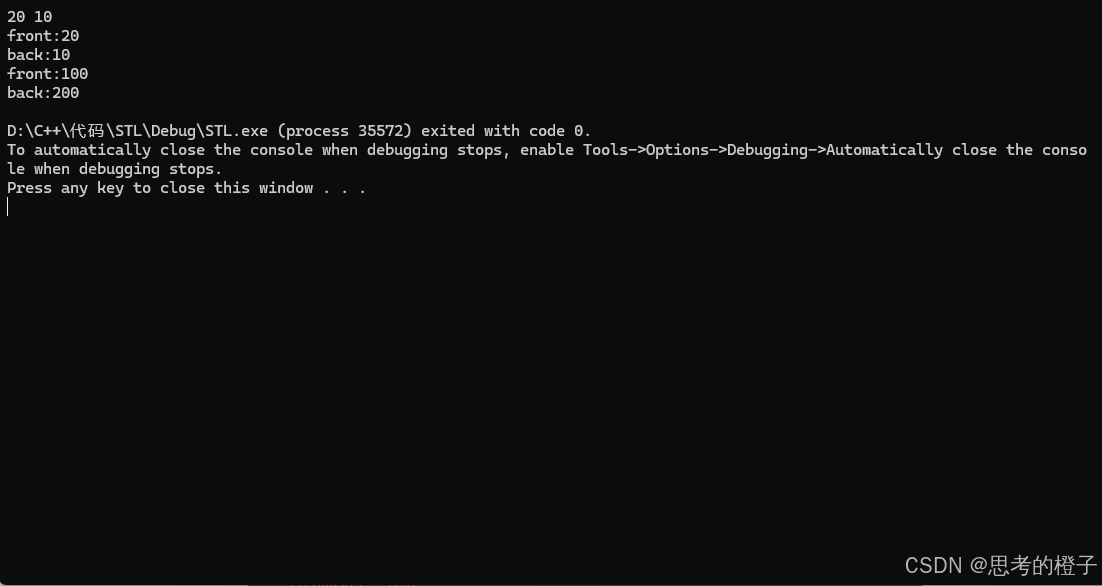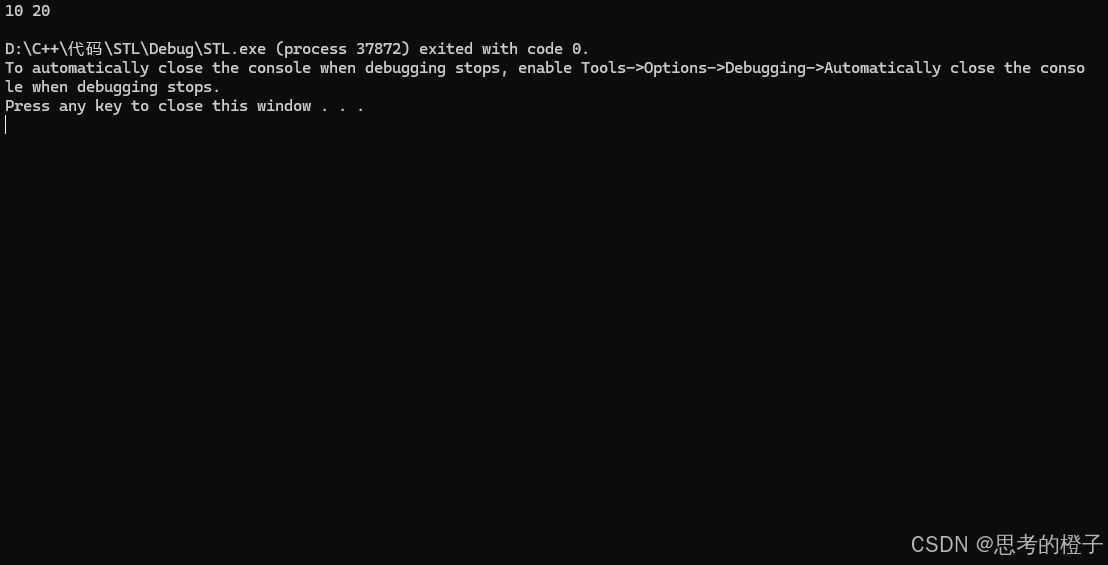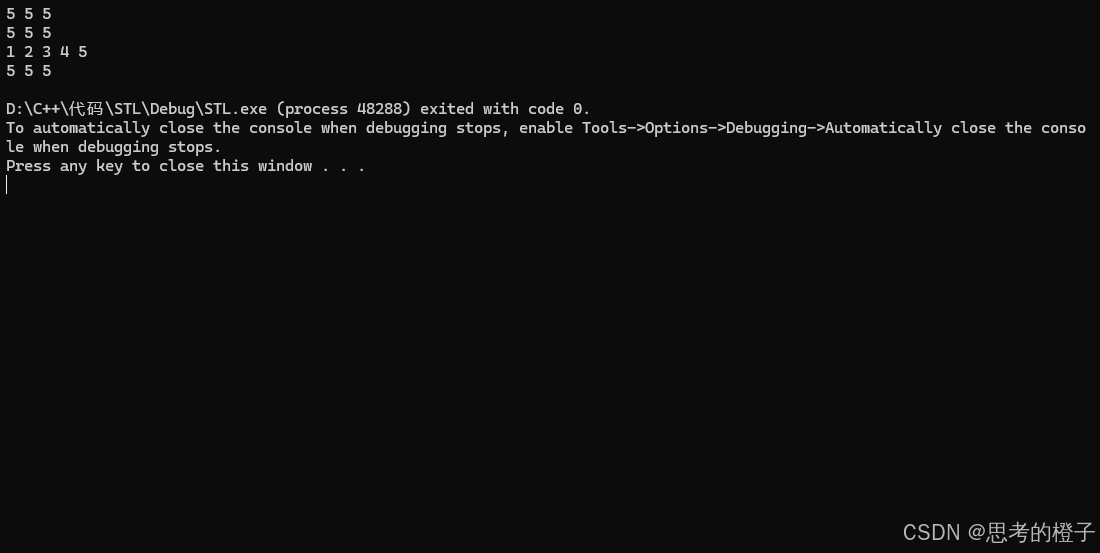list容器
头文件:#include<list>
-
list是一个双向链表容器,可高效地进行插入删除元素
-
list不可以随机存取元素,所以不支持at.(pos)函数与[]操作符
注:list使用迭代器访问数据时可以一步一步走自增自减(即it++)不允许跨太多步去访问元素
list容器是可以进行遍历的,即进行数据访问时不会进行删除操作
list头尾的添加移除操作
-
list.push back(elem); //在容器尾部加入一个元素
-
list.pop _back(); //删除容器中最后一个元素
-
list.push front(elem); //在容器开头插入一个元素
-
list.pop_front(); //从容器开头移除第一个元素
list的数据存取
list.front();//返回第一个元素。
list.back(); //返回最后一个元素。
list与迭代器
-
list 容器的迭代器是"双向迭代器":双向迭代器从两个方向读写容器。除了提供前向迭代器的全部操作之外,双向迭代器还提供前置和后置的自减运算。
-
list.begin(); //返回容器中第一个元素的选代器
-
list.end(); //返回容器中最后一个元素之后的迭代器
-
list.rbegin(); //返回容器中倒数第一个元素的选代器
-
list.rend(); //返回容器中倒数最后一个元素的后面的选代器
示例1:list与正向迭代器
cpp
#include<iostream>
#include<list>
using namespace std;
int main() {
list<int> lst;
lst.push_back(10);
lst.push_front(20);
list<int>::iterator it;
for (it = lst.begin(); it != lst.end(); it++) {
cout << *it << ' ';
}
cout << endl;
int a = lst.front();
cout << "front:" << a << endl;
int b = lst.back();
cout << "back:" << b << endl;
//修改容器末尾和首部的值
lst.front() = 100;
lst.back() = 200;
a = lst.front();
cout << "front:" << a << endl;
b = lst.back();
cout << "back:" << b << endl;
}
示例2:list与反向迭代器
cpp
#include<iostream>
#include<list>
using namespace std;
int main() {
list<int> lst;
lst.push_back(10);
lst.push_front(20);
list<int>::reverse_iterator it1;
for (it1 = lst.rbegin(); it1 != lst.rend(); it1++) {
cout << *it1 << ' ';
}
cout << endl;
}
list对象的带参数构造
-
list(n,elem); //构造函数将n个elem拷贝给本身
-
list(beg,end); //构造函数将[beg,end)区间中的元素拷贝给本身
-
list(const list &lst); //拷贝构造函数。
cpp
#include<iostream>
#include<list>
using namespace std;
int main() {
list<int>::iterator it;
list<int> lst(3, 5);
for (it = lst.begin(); it != lst.end(); it++) {
cout << *it << ' ';
}
cout << endl;
list<int> lst2(lst.begin(),lst.end());
//list<int> lst2(lst.begin(), lst.begin()+5);错误
for (it = lst2.begin(); it != lst2.end(); it++) {
cout << *it << ' ';
}
cout << endl;
int a[] = { 1,2,3,4,5 };
list<int> lst3(a, a + 5);
for (it = lst3.begin(); it != lst3.end(); it++) {
cout << *it << ' ';
}
cout << endl;
list<int> lst4(lst);
for (it = lst4.begin(); it != lst4.end(); it++) {
cout << *it << ' ';
}
cout << endl;
}
list的赋值
-
list.assign(beg,end); //将[beg,end)区间中的数据拷贝赋值给本身。注意该区间是左闭右开的区间。
-
list.assign(n,elem); //将n个elem拷贝赋值给本身
-
list& operator=(const list &lst); //重载等号操作符
-
list.swap(lst); // 将lst与本身的元素互换。
示例:
cpp
#include<iostream>
#include<list>
using namespace std;
int main() {
list<int> lst1,lst2;
list<int> lst3 = { 1,2,3,4,5 };
list<int>::iterator it = lst3.end();
list<int>::iterator it2;
lst1.assign(lst3.begin(), it);
for (it2 = lst1.begin(); it2 != lst1.end(); it2++) {
cout << *it2 << ' ';
}
cout << endl;
cout << endl;
lst2.assign(3, 5);
for (it2 = lst2.begin(); it2 != lst2.end(); it2++) {
cout << *it2 << ' ';
}
cout << endl;
cout << endl;
lst2 = lst1;
for (it2 = lst1.begin(); it2 != lst1.end(); it2++) {
cout << *it2 << ' ';
}
cout << endl;
cout << endl;
lst1.swap(lst2);
for (it2 = lst1.begin(); it2 != lst1.end(); it2++) {
cout << *it2 << ' ';
}
cout << endl;
for (it2 = lst2.begin(); it2 != lst2.end(); it2++) {
cout << *it2 << ' ';
}
cout << endl;
}list的大小
-
list.size(); //返回容器中元素的个数
-
list.empty(); //判断容器是否为空
-
list.resize(num); //重新指定容器的长度为num,若容器变长,则以默认值填充新位置。如果容器变短,则末尾超出容器长度的元素被删除。
-
list.resize(num,elem); //重新指定容器的长度为num,若容器变长,则以elem值填充新位置。如果容器变短,则末尾超出容器长度的元素被删除。
list的插入
-
list.insert(pos,elem)//在pos位置插入一个elem元素的拷贝,返回新数据的位置
-
list.insert(pos,n,elem);//在pos位置插入n个elem数据,无返回值
-
list.insert(pos,beg,end);//在pos位置插入[beg,end)区间的数据,无返回值
注:list进行数据的插入时是没有空间的释放和位置的移动,因此不会出现迭代器失效的情况
list的删除
-
list.clear(); /X移除容器的所有数据
-
list.erase(beg,end); //删除[beg,end)区间的数据,返回下一个数据的位置。
-
list.erase(pos); //删除pos位置的数据,返回下一个数据的位置。
-
lst.remove(elem); //删除容器中所有与elem值匹配的元素。
list的反序排列
- lst.reverse(); //反转链表,比如lst包含1,3,5元素,运行此方法后,lst就包含5,3,1元素
Iist迭代器失效
- 删除结点导致迭代器失效
删除即是将相应数据位置的元素地址释放掉,即返还给内部系统,在某些编译器中,该被释放的地址是可以进行访问并有明确复制(系统内部赋值),该系统地址是没有访问权限的,俗称野指针
示例:
cpp
#include<iostream>
#include<list>
using namespace std;
int main() {
list<int> lst = { 1,2,1,4,5 };
list<int>::iterator it;
for (it = lst.begin(); it != lst.end();) {
if (*it == 1) {
it = lst.erase(it);
}
else it++;
}
for (it = lst.begin(); it != lst.end(); it++) cout << *it<<' ';
}
